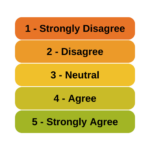 Is it really ok to treat Likert items as continuous?
Is it really ok to treat Likert items as continuous?  And can you just decide to combine Likert items to make a scale? Likert-type data is extremely common—and so are questions like these about how to analyze it appropriately. (more…)
And can you just decide to combine Likert items to make a scale? Likert-type data is extremely common—and so are questions like these about how to analyze it appropriately. (more…)
predictive models
Member Training: Analyzing Likert Scale Data
August 31st, 2022 by TAF SupportMember Training: A Predictive Modeling Primer: Regression and Beyond
May 31st, 2019 by guest contributer Predicting future outcomes, the next steps in a process, or the best choice(s) from an array of possibilities are all essential needs in many fields. The predictive model is used as a decision making tool in advertising and marketing, meteorology, economics, insurance, health care, engineering, and would probably be useful in your work too! (more…)
Predicting future outcomes, the next steps in a process, or the best choice(s) from an array of possibilities are all essential needs in many fields. The predictive model is used as a decision making tool in advertising and marketing, meteorology, economics, insurance, health care, engineering, and would probably be useful in your work too! (more…)
Descriptives Before Model Building
January 28th, 2019 by Jeff Meyer One approach to model building is to use all predictors that make theoretical sense in the first model. For example, a first model for determining birth weight could include mother’s age, education, marital status, race, weight gain during pregnancy and gestation period.
One approach to model building is to use all predictors that make theoretical sense in the first model. For example, a first model for determining birth weight could include mother’s age, education, marital status, race, weight gain during pregnancy and gestation period.
The main effects of this model show that a mother’s education level and marital status are insignificant.
(more…)
Using Predicted Means to Understand Our Models
January 14th, 2019 by Jeff MeyerThe expression “can’t see the forest for the trees” often comes to mind when reviewing a statistical analysis. We get so involved in reporting “statistically significant” and p-values that we fail to explore the grand picture of our results.
It’s understandable that this can happen. We have a hypothesis to test. We go through a multi-step process to create the best model fit possible. Too often the next and last step is to report which predictors are statistically significant and include their effect sizes.
Differences in Model Building Between Explanatory and Predictive Models
October 8th, 2018 by Jeff MeyerSuppose you are asked to create a model that will predict who will drop out of a program your organization offers. You decide to use a binary logistic regression because your outcome has two values: “0” for not dropping out and “1” for dropping out.
Most of us were trained in building models for the purpose of understanding and explaining the relationships between an outcome and a set of predictors. But model building works differently for purely predictive models. Where do we go from here? (more…)
